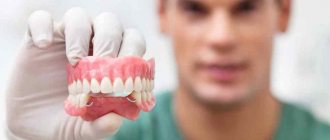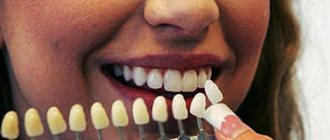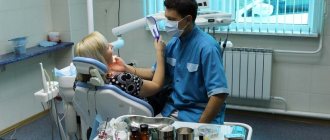- Signs of correct bite
- Types of malocclusion
- Why do you need to correct your bite?
- Until what age can a bite be corrected?
- Ways to correct a bite
- Aligners
- Trainers
- Veneers
- Bracket system
- Types of braces
- Which braces system should you choose?
- How long does it take to correct a bite?
- How to care for braces?
Malocclusion occurs in almost 80% of the Russian population. In a third of cases it requires orthodontic treatment. And it’s not just a matter of aesthetics - if you are often bothered by headaches, earaches and dizziness, then perhaps it’s a malocclusion. An orthodontist deals with the correction and prevention of malocclusions.
The most common misconception about bite is related to age. Many people think that it can only be corrected in childhood, but today, with the advent of new technologies, this can be done at any age.
In this article we will look at the causes and types of malocclusion and why it needs to be corrected. We will also tell you about treatment methods and dispel the most common fears. Orthodontist Olesya Milagina comments on current issues of orthodontic treatment for us.
Signs of correct bite
To begin with, we will show what a normal bite looks like and list the signs by which you can understand that it is normal.
- The main distinguishing feature of a correct bite is the tight contact of the upper and lower jaws when they close. The upper front teeth cover the crowns of the lower ones by a third, that is, the lower incisors come into contact with the palatine tubercles of the upper ones. There is no distance between the upper and lower chewing teeth, and during chewing they are in constant contact.
- Correct bite affects the harmony of facial proportions: the lower and upper jaws are symmetrical.
- There are no speech defects.
- Food is comfortable to bite and chew.
- There is no discomfort or clicking in the jaw joint.
Diagnosis of orthodontic diseases
It is important for a pediatric orthodontist to see a comprehensive picture - not only the current state of the oral cavity, but also the rudiments of future teeth and the structure of bone tissue. To do this, the dentist chooses several diagnostic methods:
- Orthopantomography (OPTG) is an x-ray of the bones of the facial skeleton when all the teeth are aligned in one line.
- Teleroentgenogram (TRG) is an x-ray of the jaw in the frontal and lateral projections of the skull.
- Casts are real-size simulations of the jaw to evaluate the position, shape and size of individual teeth.
- Photographing of the face and oral cavity to assess asymmetry, external deformations, and carry out calculations.
- Computed tomography (CT) is a three-dimensional image of the jaw in digital format.
- Video recording - recording abnormal manifestations of jaw function in dynamics.
Also, a pediatric orthodontist may refer the patient for a consultation with dentists or doctors of other specializations to obtain an additional professional opinion.
Types of malocclusion
How can you tell if your bite is wrong? Essentially, these are all deviations from the norm that nature has established.
Malocclusion occurs:
- distal - the upper jaw is pushed forward more than the lower jaw;
- mesial - the lower jaw is pushed forward more than the upper jaw;
- deep - the upper teeth overlap the lower ones by more than half their length;
- open - most of the teeth of the upper and lower jaws do not meet;
- cross - the left and right sides of the upper dentition protrude forward unevenly, and the upper and lower teeth meet with cutting edges.
Stages of consultation and treatment
You need to understand that orthodontic treatment is a long-term process that requires several appointments, or even years of treatment. One visit won't solve anything. The doctor acts as follows:
- First comes the diagnosis, which usually includes not only a visual examination, but also a variety of research methods, for example, orthopantomogram, x-ray, teleradiography. All directions are issued at the first visit.
- Afterwards, the doctor chooses a treatment and prepares the patient for it. The specialist does a lot of work without the client’s participation, for example, everything that an orthodontist does when preparing braces, crowns, etc. The doctor works using photographs, impressions and other tools, analyzing the data obtained during diagnosis.
- The third stage is the installation of hardware in the patient’s oral cavity. This usually doesn't take much time.
- Next comes monitoring how the treatment progresses. If problems are observed, the specialist will correct them in a timely manner.
- The last stage is the removal of devices to correct the dentition.
It is noteworthy that if parents know who an orthodontist is through personal experience, then the child will also most likely get to know this specialist. Many problems, unfortunately, are hereditary.
Why do you need to correct your bite?
- Increased abrasion, caries and tooth loss.
Normally, when chewing, the load is evenly distributed across all teeth. When there is a malocclusion, the load on some teeth increases, while on others there is practically no load. On teeth that “work for two,” the enamel wears off faster, chips appear, and the teeth themselves become loose. Teeth that are “resting” are more vulnerable to caries. - Gum diseases.
With an incorrect bite, the teeth can be tilted inward or, conversely, turned toward the lips. Eating or even normal conversation can injure the inside of the cheeks and tongue. The gums also suffer: the volume of tissue gradually decreases, exposing the roots of the teeth. - Diseases of the temporomandibular joint.
Incorrect positioning of the incisors over time leads to displacement of the jaw joints relative to each other. The pathology is accompanied by muscle spasms, bruxism, crunching and clicking while eating or talking. - Diseases of the food tract.
The bite is responsible for chewing and swallowing, and defects in the bite disrupt this process. Poorly chopped products are an additional burden on the gastrointestinal tract, which provokes gastritis, enterocolitis and problems with stool. - Breathing problems and ENT diseases.
The accumulation of bacteria in the mouth during an open bite can cause sinusitis, sinusitis, otitis media, and sore throat. - Communication problems and complexes.
For 60% of patients, braces are aesthetics; for the remaining 40%, it is either the functionality of the masticatory apparatus, or a solution to a problem with the temporomandibular joint, or a preparatory stage before prosthetics.
Anomalies of teeth
An incorrect bite can occur due to the following anomalies:
- anomalies of both individual teeth and several (for example, teeth are rotated, tilted, erupt in the wrong place, or the patient simply has supernumerary teeth);
- abnormalities of the jaws (for example, backward displacement of the jaw, protrusion and insufficient development);
- anomalies of the dentition (for example, the inclination of several teeth towards the tongue and in the opposite direction, gaps between them or, conversely, a crowded arrangement).
Ways to correct a bite
Today there are four ways to correct a bite and one way to carefully disguise the problem.
- Aligners
- Trainers
- Bracket systems
- Surgical intervention
We have listed these methods in order from easiest to most difficult. You must understand that each case is individual, and depending on this, the doctor will select the optimal bite correction system. You can hide an unaesthetic bite with the help of veneers - we will also talk about them.
Aligners
Removable aligners that are created from dental impressions. The most modern way to correct a bite, which is suitable for the treatment of simple disorders.
After drawing up a treatment plan, the patient receives 3–5 sets of aligners of varying stiffness. The mouth guard is designed to last for two weeks, and then it needs to be changed to the next one, and so on until the final result. The course of treatment lasts on average 4–8 weeks.
Aligners need to be worn 24 hours a day, and this may not be comfortable for everyone. They are not suitable for deep bites. The mouthguard is designed so that it is “one step” ahead of the current position of the teeth in the dentition. Therefore, after putting it on, pressure is felt, which is evenly distributed throughout the jaw. Aligners consist of an elastic transparent material, so they are invisible to others, unlike braces.
Trainers
Removable silicone mouth guards for two jaws, which help correct a simple bite or consolidate the result. You need to wear the trainer during sleep and during the day for up to 4 hours.
Veneers
The characteristics are similar to crowns, but they are installed only on the front surface of the tooth in the form of a thin plate on a special dental glue.
Veneers can be composite, ceramic or zirconium. The first two types last about 10 years. Products made of zirconium dioxide with external porcelain coating - up to 15 years.
Veneers eliminate defects that arise as a result of cracks or damage to the integrity of teeth. A visually straight dentition is formed.
For the patient, the result of orthodontic treatment is aesthetics, and for the doctor, it is functionality. If your teeth are just crooked and your bite is perfect, you can get veneers or crowns. In other cases, you cannot do without braces: veneers do not correct the position of the teeth, but only mask their external imperfections.
Bracket system
Braces are small clasps that are attached to the teeth with a special composite glue. A metal arch is placed in the grooves of the braces - the most important element of the braces system. The arch has the shape of a regular dentition. She pulls her teeth, setting them in the correct position. In order for the bracket system to successfully complete its work, it is important to periodically change the arches to more elastic ones.
The doctor fixes the arch on the braces with special rubber bands - ligatures. Depending on the task at hand and the required force that will act on each tooth and jaw as a whole, the orthodontist can choose metal or elastic ligatures. The latter have a clear advantage - when they are changed, you can get rid of the bacteria accumulated under them.
Increased salivation in the first days after installation is a good reaction of the body. The tongue contains sensory neurons that, when food appears in the mouth, send signals to the brain to turn it into a food bolus. When braces are put on your teeth, at first the brain perceives them as food. This is the body’s reflex that there is something in the mouth, which means it needs to be treated with saliva in order to then swallow it. After some time, the salivary glands will get used to it.
Does it hurt to wear braces?
The first days are unusual, but not painful. But if braces scratch your lips and cheeks, you shouldn’t tolerate it. “ Make an appointment with your orthodontist. Sharp elements can be corrected with special materials and filled with special wax
“, our expert advises.
The same applies to tooth sensitivity: sign up for a diagnosis. It is possible that areas of demineralization have appeared. Depending on what the teeth react to, further treatment will depend.
Types of braces
Braces are classified according to the following criteria:
- material (metal, plastic, ceramic and sapphire);
- technique (classical and self-ligating, without ligatures);
- Place of installation (on the outer surface of the teeth - vestibular, on the inner surface - lingual).
Metal braces
Despite the fact that these are the oldest braces systems, they are still popular, and not only because they are the cheapest. Their main advantage is the minimal friction force between the groove and the arc, the magnitude of which largely determines the duration of the entire treatment.
The only negative is that such braces are noticeable on the teeth. However, modern designs differ from their ancestors - they are smaller and more convenient.
Plastic braces
Second after metal ones in the price range. Since plastic itself is not strong enough, the design has metal grooves. Their disadvantage is that such braces are stained by coffee, tea and other coloring products. They are also more fragile than others. However, plastic braces come in a variety of colors and shapes and are therefore popular in pediatric orthodontics.
Ceramic braces
More expensive, but stronger than plastic ones. The color matches the color of the teeth, which makes them almost invisible. Their disadvantage is higher friction between the arch and the bracket slot, which can increase the duration of treatment.
Sapphire braces
Artificial sapphires are used to make them. They are transparent and shimmer beautifully in certain lighting. This design will appeal to those who are sensitive to aesthetics.
Combined braces
Consist of several materials. In the smile area it can be ceramics or sapphires, and in the chewing area it can be metal.
Lingual braces
They are attached to the inside of the teeth and are invisible to others. Their main disadvantage is their high cost. Also, at first they may interfere with diction, but after 2-3 weeks the language adapts and the problem goes away.
When to contact an orthodontist
A child should learn who an orthodontist is before the age of 7. At this age, the permanent bite of the anterior incisors is still forming, so it is possible to stop some problems relatively painlessly. Most leaflets for parents contain the following recommendations for visiting a doctor:
- The child is one year old and parents have questions. What does an orthodontist do when the baby has no teeth yet? He examines whether the lips and those teeth that have already erupted are closing correctly;
- child is 3 years old. A visit is advisable, because at a young age, the prerequisites for incorrect development of teeth and jaws can be identified. Therefore, during such an appointment, the orthodontist always asks the parents whether the baby has bad habits, for example, sucking a pacifier, finger, tongue;
- the child has difficulty swallowing, chewing, and speech is not formed;
- you see that the child has changes in the position of the teeth or their closure.
Knowing what an orthodontist does , you can visit a specialist in advance to prevent problems in the development of the dentition and avoid their deterioration.
Which braces system should you choose?
The least expensive and most proven option is metal braces. Plastic ones are also inexpensive, but they are inferior in strength to metal ones. If aesthetics are more important to you, opt for more expensive ceramic, sapphire or lingual braces.
As for “internal” braces, their only difference from all others is the aesthetic factor. One of the inconveniences is that such braces change the diction, they are more difficult to care for and they are not suitable for everyone. You need to have an almost perfect bite: just “uneven teeth.”
How to become an orthodontist
If the dentist profession appeared a long time ago, then the orthodontist is relatively recent. To qualify as an orthodontist, you must graduate from an educational institution (university) in your field. The duration of study is 5 years. Then, do an internship for 4 years. After this, you can proceed to treating patients.
A dental occlusion specialist (orthodontist) is a very necessary person in dentistry. Everything depends on it: a beautiful smile and healthy teeth.
Sources used:
How long does it take to correct a bite?
Each case is individual, so without visiting a doctor it is impossible to say how long treatment will take.
The minimum treatment takes a year for the bone to grow and the teeth not to come back. The result needs to be stabilized. Patients often tell me after two months of wearing braces: “I want to take them off, everything is already straight for me!” But this is appearance. The jaw bones must anchor the teeth into their new position.
The duration of treatment also depends on the patient. The orthodontist puts a certain force into the braces, which weakens by the next visit. That is why it is important to strictly visit the doctor once a month so that you do not have to prolong the course of treatment.
My teeth began to loosen. Something is going wrong?
Loose teeth after installation should not scare you. The teeth will be in motion throughout the treatment period. Essentially, we move our teeth: somewhere the bone dissolves, somewhere it appears. Six months after treatment, the teeth will return to normal.
The purpose of braces is to change the position of hard and soft tissues adjacent to the tooth. But this is not enough to correct the bite. Teeth may move back apart some time after braces are removed if a retention device is not in place. After correction, retainers must be installed to keep the teeth stable in their new position. If this is not done, the effect of wearing braces will gradually disappear.
Description of structures used to correct bite
1. Aligners (or mouth guards). They are made from very durable materials.
Aligners have a number of advantages:
- the structure is removed;
- they are invisible to the eye, as they are made of transparent material;
- discomfort from the aligners is minimal;
- the devices do not require specialized care. You just need to maintain hygiene by rinsing the trays with water.
2. Trainers. These structures are manufactured in series. In this regard, these devices are available to almost all groups of the population. The devices themselves are worn only a few hours a day. The wearing time depends on the doctor's prescription. Trainers are used by orthodontists to correct minor bite deformities. The peculiarity of using the devices is that they allow you to straighten teeth that are located separately from each other.
3. Braces are brackets connected by a power arc. Braces are attached to the teeth, fixing the desired position. The braces correction method is universal, as it copes with many deviations. Period of wearing braces: from 2 months to 5 years. The period of straightening depends on how crooked the teeth were at the very beginning and how the body adapts to the changes made.
How to care for braces?
Caring for braces requires care and discipline. We talked about it in more detail in a separate article. After installing braces, the doctor will tell you how to live now. We will indicate the most important things.
- Always have brushes and a single-tuft brush on hand.
- Add a waterpik to your arsenal.
- If you are not sure that you have brushed your teeth well, use an indicator tablet. After brushing your teeth, the tablet must be dissolved in your mouth. The areas where plaque remains will turn blue. These areas need to be cleaned again.
- Avoid very hot and very cold drinks. Braces, like enamel, do not like sudden temperature changes.
- To prevent braces from coming off, follow a diet. Eliminate nuts, toffees, seeds, and flour from your diet. Apples and other hard fruits should not be bitten off, but cut into small pieces and placed on the chewing teeth.
Basic information about gnathology
Gnathology is a branch of dentistry devoted to the work of the dentofacial apparatus and all its components - nerves, bones, chewing and facial muscles, periodontal tissues, joints, teeth. It is gnathology that is responsible for the correct structure of the jaw, normal chewing of food, and a beautiful smile.
Every dentist can have minimal knowledge and skills in this area, but when solving more complex and specific problems, you will definitely have to turn to a specialist - a professional gnathologist.
Stage IV - dental prosthetics
Prosthetics on an implant, as well as prosthetics of teeth in the lateral sections above and below in a physiological and stable musculoskeletal position of the lower jaw, created all the prerequisites for the correct functioning of the TMJ. Crowns are installed on the teeth on a zirconium dioxide frame.
After dental prosthetics:
Uneven position of teeth and exposure of cervical areas of teeth
Before
Stages
After
Specialists:
Denisova Ekaterina Alexandrovna
Description:
In addition to the uneven position of the teeth, the patient’s main complaint was the exposure of the cervical areas of the teeth, the appearance of wedge-shaped defects and, as a result, increased sensitivity. Such nuances appear when the dental system is overloaded due to the lack of correct functional guidance (lack of normal position of the canine, in particular, on the right side). And also in case of incorrect position of the teeth relative to the bone tissue of the jaw.
Based on the results of orthodontic treatment after 18 months, under the control of a computer tomogram, we corrected the position of the roots relative to the bone tissue of the jaws and built a correct occlusal scheme, where the teeth do not experience overload. This work made it possible to reduce the severity of previously existing recessions.
Specialization
Surgeons perform surgical interventions, an orthodontist restores the correct bite using braces and removable or fixed plates, a periodontist treats inflammatory processes in the gums.
An orthopedic dentist is responsible for prosthetics and dental restoration.
Important: All highly specialized doctors work together, since any restoration of the oral cavity requires an integrated approach and comprehensive treatment.
The need to tighten braces
When using this type of bite correction, the teeth move into the correct position. This is a rather long and painful process. The braces are secured using a special arch, which must be periodically tightened as the teeth move. This is also done by an orthodontist who installs the braces system.
How often to tighten the metal arch depends on the degree of curvature of the patient’s teeth and is determined individually. On average, this procedure is performed once every few months; a doctor called an orthodontist will help you determine the exact frequency of visits. This depends on the material from which the braces are made, the condition of the patient’s teeth and the total duration of the course of therapy.
It is not recommended to skip such visits, otherwise the effectiveness of braces will be significantly reduced. On average, correcting a bite takes 3 years or more, so you need to prepare for multiple visits to the doctor.
During braces tightening, a person may experience pain, and you need to be prepared for this. This process is associated with increased pressure on the teeth as they move. In some cases, doctors may prescribe local pain medications. If the arch is tightened incorrectly, discomfort may occur while talking or eating. In this case, you must inform the doctor who installed the braces.
Another prerequisite is oral care during treatment with such structures. It involves the use of special toothbrushes, toothpastes and mouth rinses. Your doctor will help you select the necessary medications; he will also explain how to brush your teeth while wearing braces.
Category Orthodontics Published by Mister stomatolog
When should you choose a clinic?
- You want to carry out several types of treatment in one clinic.
If you first need caries treatment, then bite correction, and then installation of veneers, implantation or whitening, loyalty to one clinic can help save more than one thousand rubles: many clinics have discount programs for regular patients. In addition, it will be more convenient to visit one medical institution.
Wholesale - often cheaper
- You are constantly running out of time.
Since correcting a bite is a rather expensive treatment, patients often choose a clinic that is not the most convenient, sometimes even in another city if the prices are lower there. Is it worth doing this? This is a controversial issue, since savings are not always justified over a long period of time. In addition, you will need money for travel. And if you can’t go to the clinic on the appointed day to activate the system or replace the aligners, the treatment process will stop until the next appointment. In any case, it is better for busy people to choose the clinic that is closer to home or work. This will help you avoid missing or rescheduling appointments. After all, for quick and successful treatment, it is important to visit the doctor strictly on the appointed dates.
It is much more profitable to use the installment program, which is now offered by almost all clinics. Payment in installments is available to most patients, and there is no need to try to save money, with the risk that the treatment process will suffer.










